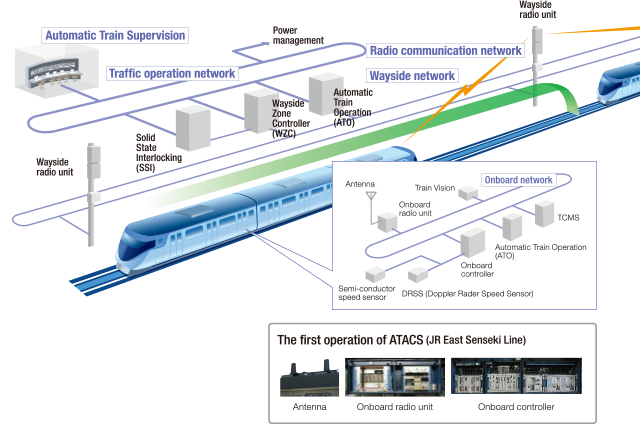Transportation Systems
Train Operation Systems
Train Operation Systems
Rising to the challenge of new forms of transportation in the ICT era.
We’re ensuring safe and stable transportation through
the optimization of trainset operation and operation control.
In addition, precise train control realized through combining onboard
and wayside equipment optimizes
energy consumption throughout the entire transportation system.
Automatic Train Supervision (ATS)
These systems enable centralized monitoring and control of train operation. User interfaces that offer superior visibility and operability enable accurate understanding of the status of train operation and rapid and precise command decisions. Diverse functions also assist in the formulation of operation plans.


Operation monitoring screen

Schedule planning screen

Operation control screen

Crew scheduling
support screen
Passenger Information Control (PIC)
LCD panels display train departure and arrival information, line information, advertisements, etc. Videos, still images and information in letters and characters can be freely combined.

Passenger information display (LCD)

Passenger information display (Full-color LCD)
Radio train control systems (ATACS*1/CBTC*2)
These systems enable trains to detect their own position, and enable control via two-way radio transmission between onboard and wayside equipment. In addition to making it possible to streamline wayside equipment (doing away with signals, etc.), cooperation between onboard and wayside equipment using advanced radio technology enables high-density operation, automatic operation and power-saving operation.
*1 Advanced Train Administration and Communications System:
A signal security system developed by JR East
*2 Communication–Based Train Control System


Wayside equipment
Wireless technology enables position data and control data for each train to be exchanged, and control to be applied to the distance between trains, speed, route, etc.
The use of a failsafe processor ensures a high level of safety.


Control unit

Solid State
Interlocking (SSI)


Wayside Zone
Controller (WZC)
Radio equipment
A full lineup of radio equipment tailored to train control using the radio LAN band, the train radio band, etc. Ensures stable communication quality.

Onboard radio unit

Wayside radio unit
Onboard equipment
Obtains control data related to the interval between trains while transmitting position data for the subject train to wayside zone controller via radio communications, enabling ATO to be applied within a restricted speed.


Onboard controller


Automatic Train
Operation (ATO)